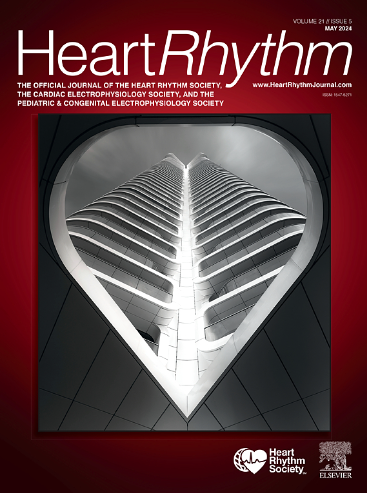Chronic wireless communication between dual-chamber leadless pacemaker devices
IF 5.7
2区 医学
Q1 CARDIAC & CARDIOVASCULAR SYSTEMS
引用次数: 0
Abstract
Background
Aveir DR (Abbott, Abbott Park, IL) is a dual-chamber leadless pacemaker (LP) system with distinct atrial and ventricular LPs (ALP, VLP) that communicate wirelessly to deliver atrioventricular synchronous pacing. Success rates of these implant-to-implant (i2i) transmissions have not been systematically evaluated.
Objective
This study aims to evaluate chronic i2i success rates in a clinical setting.
Methods
Patients meeting standard dual-chamber pacing indications were enrolled and implanted with dual-chamber LP systems as part of a prospective international clinical trial (Aveir DR i2i Study). The percent of successful i2i transmissions from ALP-to-VLP (A-to-V) and VLP-to-ALP (V-to-A) were interrogated from LPs in de novo patients using the device programmer at implant, discharge, and at 1, 3, and 6 months postimplant (1M, 3M, 6M).
Results
A total of 399 patients completed device implant and i2i diagnostic interrogation (62% male; age 69 years; 65% sinus node dysfunction, 32% atrioventricular [AV] block). Median A-to-V and V-to-A i2i success rates exceeded 90% of beats at all time-points from implant to 6M. The minority of patients with A-to-V or V-to-A i2i success in <70% of beats at implant (A-to-V: 19% of patients, V-to-A: 31% of patients) showed roughly 40% improvement by 1M, with this minority dropping to roughly 5% of patients by 6M. Improvement in i2i communication success may be attributed to reprogramming of i2i setting levels, natural changes in dominant posture, and device stabilization.
Conclusion
Wireless implant-to-implant communication in the new dual-chamber leadless pacemaker system demonstrated successful transmissions in >90% of beats throughout the 6-month evaluation period. Communication success improved significantly over time postimplant for specific subgroups.
Clinical Trial Registration
Aveir DR i2i Study, ClinicalTrials.gov ID NCT05252702.

双腔无导线起搏器设备之间的慢性无线通信。
背景:Aveir™ DR(雅培)是一种双腔无导联起搏器(LP)系统,具有不同的心房和心室 LP(ALP、VLP),可通过无线通信实现房室同步起搏。这些植入体对植入体(i2i™)传输的成功率尚未得到系统评估:评估临床环境中的慢性 i2i 成功率:作为前瞻性国际临床试验("Aveir DR i2i 研究")的一部分,符合标准双腔起搏适应症的患者被纳入并植入了双腔 LP 系统。在植入、出院以及植入后 1 个月、3 个月和 6 个月(1 个月、3 个月、6 个月)时,使用设备编程器对新患者的 LP 进行了 ALP 至 VLP(A-to-V)和 VLP 至 ALP(V-to-A)的 i2i 成功传输百分比检测:399名患者完成了设备植入和i2i诊断检查(62%为男性;年龄69岁;65%为窦房结功能障碍,32%为房室传导阻滞)。从植入到 6 个月的所有时间点,A-V 和 V-A i2i 成功率中位数均超过 90%。结论:A-to-V 或 V-to-A i2i 成功的患者占少数:在为期 6 个月的评估期间,新型双腔无导线起搏器系统的植入对植入无线通信成功率超过 90%。随着植入后时间的推移,特定亚组的通信成功率明显提高。
本文章由计算机程序翻译,如有差异,请以英文原文为准。
求助全文
约1分钟内获得全文
求助全文
来源期刊

Heart rhythm
医学-心血管系统
CiteScore
10.50
自引率
5.50%
发文量
1465
审稿时长
24 days
期刊介绍:
HeartRhythm, the official Journal of the Heart Rhythm Society and the Cardiac Electrophysiology Society, is a unique journal for fundamental discovery and clinical applicability.
HeartRhythm integrates the entire cardiac electrophysiology (EP) community from basic and clinical academic researchers, private practitioners, engineers, allied professionals, industry, and trainees, all of whom are vital and interdependent members of our EP community.
The Heart Rhythm Society is the international leader in science, education, and advocacy for cardiac arrhythmia professionals and patients, and the primary information resource on heart rhythm disorders. Its mission is to improve the care of patients by promoting research, education, and optimal health care policies and standards.
 求助内容:
求助内容: 应助结果提醒方式:
应助结果提醒方式:


